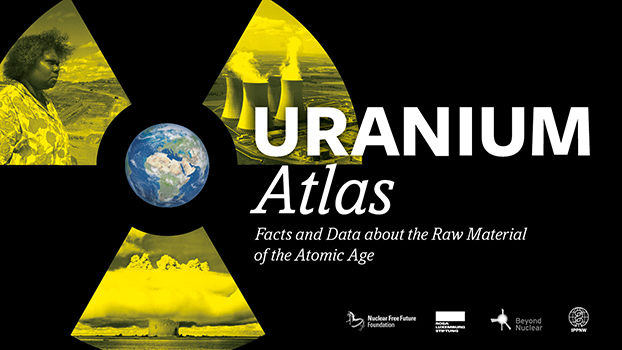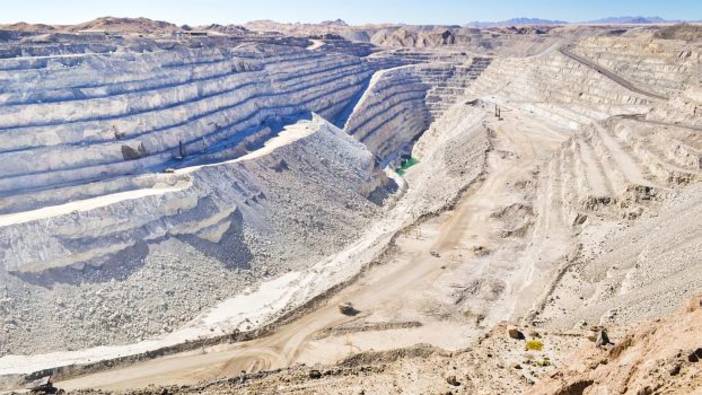
The raw material uranium appearsto be indispensable. The slogans are “extraction without major risks”, “winnable nuclear first strike” and “nuclear power as a climate-neutral alternative”. Global policy is currently also nuclear policy. The nuclear industry does its best to sit at the table everywhere.
But the reality is different: the Global North externalizes environmental and health risks through uranium mining in the Global South. Although uranium has reached a historically low price, the actual costs of nuclear power are gigantic, even if one does not include waste storage. This in turn is still unsolved in most countries that rely on nuclear power. Not to mention that nuclear weapons continue to be built as arsenals of intimidation.
The Uranium Atlas, published by the Nuclear Free Future Foundation, the Bund für Umwelt und Naturschutz Deutschland, the Rosa-Luxemburg-Stiftung and Le Monde diplomatique, illustrates the global dimension, the risk, the resistance against uranium mining and nuclear energy. The Uranium Atlas offers access to a complex matter that is hardly ever discussed in public.
From the Preface
A creation story of the Diné, an Indigenous Nation in the Southwest of the United States, speaks of two kinds of yellow dust: the first humans were told that the yellow dust of corn pollen would secure their life. The other yellow powder however would endanger it. They were instructed to leave the other yellow powder – uranium – in the soil and never dig it up. If it were taken from the ground, they were told, a great evil would come.
And the evil came. Uranium, traded globally, even has a name reminiscent of this story from the beginning of time. It is called yellowcake. More than three thousand Diné, who are also called Navajo, worked in the uranium mines in the 1950s, without special work clothes or any kind of radiation protection. Covered in radioactive dust, they walked home to their families – and without knowing it, contaminated their loved ones. People are still dying in Dinétah, the land of the Navajo. The danger is not contained, since almost a thousand abandoned mines still contaminate the region.
Winona LaDuke, born in 1959, activist, author and member of the Anishinabe Nation, lives on the White Earth Reservation in northern Minnesota, USA. In 1977, while just out of high school, she spoke at the United Nations in Geneva and for the first time revealed that most North American uranium was extracted on Indigenous lands.
When we, the Indigenous people of Turtle Island – that’s what we call North America in our tribal language – fight against uranium mining, we do this shoulder to shoulder with all Indigenous peoples everywhere in the world, fighting for the same goals. This is not only about our survival, but about the survival of all creatures. We are all one family. The industrial society wages war against the Earth. We see ourselves as children of this Earth and therefore this war is a war against us.
The first inhabitants of the Australian continent delivered a similar warning: He who disturbs the sleep of the rainbow serpent unleashes evil forces which cannot be tamed by humans. The Aboriginals in the Northwest of the continent say that by tearing up the uranium veins, we awaken the sleeping snake. You do not need to be a rocket scientist to see that the nuclear path is a path over the edge of a cliff.
Uranium is not just lying there, waiting for its exploitation. That is the image the media and textbooks want to convey: raw materials are waiting, eager to uphold western civilization and the modern world’s infrastructure. It should be noted that uranium mining is not the only threat – oil extraction from tar sands also leaves behind dead and uninhabitable landscapes. But what we don’t see is where the resources come from and what devastation is left behind after their exploitation. What kind of civilization does not allow its people to learn the truth? In our Indigenous cultures we teach our kids that we humans are responsible for the consequences of our actions. However, we can only assume this responsibility when we know the consequences of our actions. The industrial society we live in is afraid of the truth.
The best minds in the nuclear establishment for decades have agonized over the question: where to dispose of the nuclear waste? In the United States, one solution appeared very attractive: dispose of the waste on Indian reservations - in a cloak-and-dagger operation! Thus we, the Indigenous people, are at the beginning and the end of the nuclear chain. Each nation committing to nuclear energy must understand that they are complicit. Uranium is killing us.
I would like to refer to another prophecy, this time coming from my people, the Anishinabe, also called Ojibway. This prophecy talks of a time when we will be at a crossroads and have to choose between two paths: the one path is worn and scorched, the other hardly travelled and green. We are now at this crossroads. The future is shown as green, also for us Indigenous people. In order to reduce their CO2 emissions, the United States needs to build clean power plants with an output of 185,000 megawatts within the next ten years. We can contribute to this goal, because where we live the winds blow regularly and the sun shines as well. The reservations offer a potential of 200,000 megawatts. We, the Indigenous people, are in a position to implement alternatives in the most wasteful and destructive country on Earth. But we need to be alert, since the nuclear industry tries to sell its lies that it is working to save the environment. We must all work together and choose the green path – not the worn and scorched path.
All Uranium Atlas graphics can be downloaded separately as JPG or PNG files. They are subject to a CC-BY-4.0 license and can be used for individual purposes, if the copyright notice “Nuclear Free Future Foundation/Hoffmann, CC-BY-4.0” is placed near the graphics.
Let’s meet on the green path. Let’s leave uranium in the ground.
Winona LaDuke

